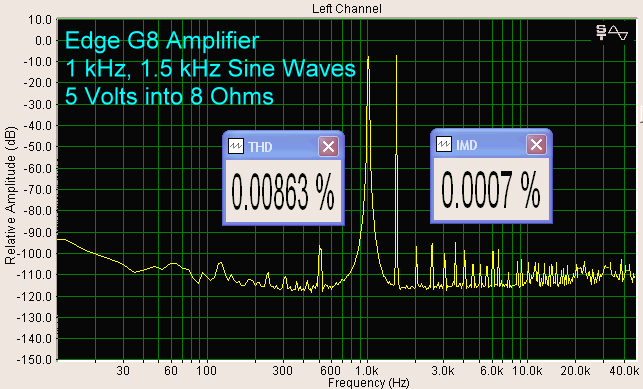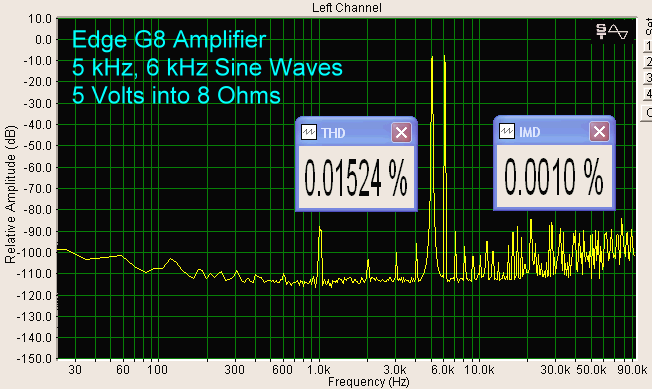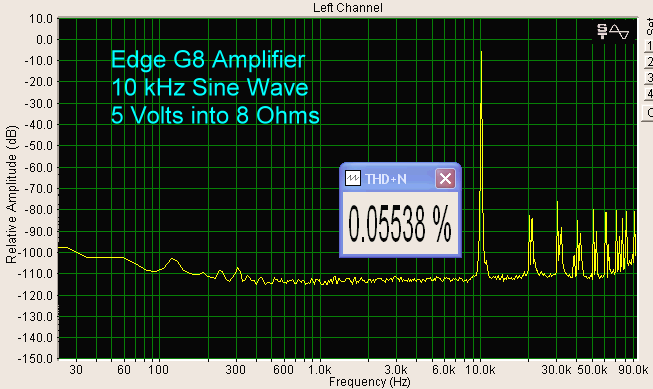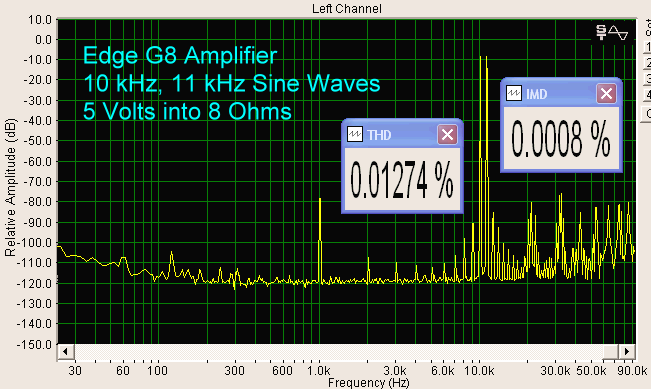|
|


|
|
Specifications:
-
RMS Power Output: 175 Watts
Per Channel into 8
Ohms
-
Transformers: One 1000 VA
-
Power Supply Filtration: 60,000
µF Per
Channel
-
Output Impedance: 0.35 Ohms
-
Input Impedance: 33 kOhms
-
Constant Current Capability: 18
Amps
-
Input Connection Type: RCA
-
Dimensions (H x W x D): 4 7/8" H
x 16 3/4" W x 15" D
-
Weight: 52 Pounds
-
MSRP: $5995
Edge Electronics
www.edgeamp.com
|
|
Introduction
I first ran into Stephen Norber, co-designer with Tom Maker of many of Edge
Electronics' preamplifiers and power amplifiers, at my first Consumer Electronics Show over
four and a half years ago. Though what I heard in the small Edge demo room
did not immediately attract me, Stephen's vibrant, positive energy and sheer
intelligence suggested that my dissatisfaction probably arose from speakers
and set-up rather than electronics.
A second listen at HE 2003, this time with very different speakers, left a
totally different and much more positive impression. And sharing time with
Stephen was again a trip and a half. The man's mind and personality are
assuredly wired to some very high current. I left the room telling Stephen
that I had to review at least one Edge product.
My eagerness was reinforced by three or four extended visits to the Edge
Showroom at T.H.E. SHOW 2004, where Edge Electronics were paired with
Ephiphany Speakers. I must have spent more time in the Edge and Joule rooms
than anywhere else. Although I was most impressed by Edge's costly NL
series, I was greatly intrigued by their new line of more affordable G8
amplifiers.
Cut to the present. Fresh from the Parasound Halo JC 1 monoblock reviewing
experience - amplifiers I intend to revisit in the next month or two when I
have additional equipment on hand - I had hoped to review the G8 monoblocks
($7995/pair). With review samples unavailable at this time, however, Secrets
was instead offered the stereo G8. While this 175 watt amp lists for
virtually the same price as the 400W JC 1 monoblocks, the sound is very
different.
A few caveats. Before the amp was shipped, Stephen told me that it needed
1000 hours of break-in time before it would sound its best. When I told him
that I was neither equipped nor willing to run music or white noise through
the amp full blast for 42 days and 42 nights, he explained that neither was
Edge equipped to do the break-in beforehand.
As you will read in my Aural Audition headphone amp review, I do find that
solid-state break-in can make a major difference in sound quality. We
ultimately decided to send the G8 to John Johnson first for bench tests.
John, who has a separate, detached listening lab where he can play music
constantly without upsetting family equilibrium, broke in the amp for a good
week.
Before John forwarded the G8 to me, I requested that he play music through it
non-stop for another seven days. As far as I'm concerned, two weeks of
amplifier break-in is more than a manufacturer can reasonably expect from a
review team.
Stephen also told me that solid-state sounds its best after warming up for
48 hours. That sure is many hours longer than most buyers warm up their
gear. Since the amp uses relatively little power when no music plays through
it, I left it on well over 48 hours before taking a first listen, and kept
it on constantly throughout the review process. (I also engaged in a similar
process when reviewing the Parasound JC 1s.) Though I have yet to evaluate
if this makes a noticeable difference, I felt that doing so would certainly
assure Edge that short of demanding payment for my highly inflated
California electric bill, I was taking whatever steps within my means to
fairly evaluate their amp.
The associated equipment and set-up procedure used for
this review is identical to that employed when playing my reference system –
that includes cleaning connections with Pro Gold, playing demagnetizing and
break-in tones, carefully isolating equipment from vibration using Ganymedes,
plus assorted bells and whistles.
Listening
The first disc I played was an advance copy of Malian vocalist Rokia
Traore's sensational Bowmboi (Nonesuch). Though the disc was first released
in the US August 24, 2004, it became available in Europe in the fall of
2003. Backed by acoustic instruments, Traore's triumph has already sold well
over 100,000 copies in France and sparked the highest possible critical
reaction.
As soon as I heard the G8's bass, I said to myself that the amp was a
keeper. The remainder of my listening experience only reinforced awareness
of the G8's excellent, fast bass response. It is a tight little amp with a
good sense of dynamic contrast.
The next day, however, questions arose. With speakers now located 12 feet
apart, I expected a spacious presentation with lots of depth. I was not
familiar with the sound of Bowmboi, but I noted that its soundstage was
narrower than I was accustomed to hearing. Sounds seemed confined between my
speakers, and lacked significant height and depth. The music was also
bright, even glaring.
Since I was in the midst of exploring female vocalists, I next turned to
Renée Olstead's self-titled whopper of a disc (Reprise). The woman is a
bombshell, which is all the scarier because she recorded the
album when she was fourteen. We're not talking teeny bopper juvenilia here;
we're talking major talent with grown-up sensibilities.
Again I experienced bright sound. It was hard to tell what was at fault,
since this was a commercial release featuring Broadway/jazz arrangements of
classics and standards. But I did know for sure that what I heard did not
encourage repeated listening.
It was time to pull out my “regulars.” First to Rachmaninoff's Symphonic
Dances (Reference Recordings), hands down one of the best orchestral
recordings available in non-SACD format. Instead of air, space, a huge
soundstage and the fabled sound of the hall that I've been hearing ever
since installing Nordost Valhalla power cables, I experienced a congested,
noisy, and overly bright image where instrumentalists seemed so crowded onto
the stage that their instruments were competing for limited space. Not good.
I immediately thought of WireWorld Gold Eclipse 5 interconnects and speaker
cable and Gold Starlight 5 digital interconnects. I quote from the
conclusion of my review of those products:
“ . . . the cables' excellent midrange and strong bass response make it a natural
for solid-state amplification and/or digital equipment that tends to
reproduce highs in an overly etched, brittle, harsh, or classically
“digital” manner. In such cases, I would greatly prefer it to the even more
neutral, transparent, and truthful Nordost Valhalla.”
This was an opportunity to put my perceptions to the test.
Without changing my reference Nordost Valhalla speaker cable, I variously
replaced first the Valhalla digital interconnect between transport and Theta
Gen. VIII DAC/preamp, then the Valhalla analog interconnect between Theta
and Edge G8 with their WireWorld top-of-the-line equivalents. Much
experimentation led to the conclusion that simply by changing the
interconnects between the Theta and Edge from Nordost Valhalla to Wireworld
Gold Eclipse 5 (and retaining Nordost Valhalla as the digital interconnect),
highs mellowed out without becoming dull, bass remained firm, and a
semblance of midrange appeared on the scene. The transformation made the G8
more than listenable. There is always the argument that a bright sound of an
amplifier can be in part due to the amplifier simply delivering a more accurate
transmission of the brightness that is inherent in some 16/44 CDs, and that
cannot be ruled out here. Down the road, with SACD and DVD-A, which use a much
higher bit-rate, that argument can be put to examination.
The conclusive test of the amp's abilities came when I returned to the
Rachmaninoff. This time, I experienced a far more acceptable presentation.
Detail was excellent, even more-so than from my reference Jadis Defy 7 tube
amp. And while I still wished for a wider soundstage, greater depth, and the
sense of boundlessness I am accustomed to hearing, a strong element of
musicality emerged which made for satisfying listening.
As I went through piles of recently arrived discs, I found myself wanting to
sit and listen to multiple tracks rather than just take notes on a portion
of one track and move on. I loved Haitian ex-patriate Marlene Dorcena's Mèsy
(Contre-Jour), and admired the smoothness of a vocal presentation that with
the ultra-transparent, neutral Nordost Valhalla in the entire chain would
have seemed glaring. At the end of the session, I sat with rapt attention
while playing the entire advance copy of soprano Dawn Upshaw's beautiful
Voices of Light (Nonesuch) recital with pianist Gilbert Kalish.
This is not to suggest that I found myself transported by the sound per se.
I wished for more resonance in Kalish's piano, more of a sense of the hall,
a wider soundstage and greater depth. But what I did hear was lovely.
Despite wanting more, the essence of the musical message came through loud
and clear. In the end, what more can one ask for?
On the Bench (JEJ)
THD at 1
kHz appears to be good, and in my experience, typical of a high performance
product that probably does not use much negative feedback.

IMD is
also low.

Using
higher frequencies, IMD is a bit higher, but still good.

THD at 10
kHz is about where I would expect it to be.

IMD is
still low at 10 kHz and 11 kHz input signals.

The
measured frequency response is ± 0.5 dB 20 Hz to 40 kHz

Conclusions
In a forthcoming revisit to Wireworld and Harmonic Tech interconnects, I
shall address in some detail the influence of cables on sound and overall
presentation. What is important to say now is that the Edge G8 is an amp for
which choice of cabling is a crucial and decisive factor.
When paired with the right cables, the Edge G8 emerges as a fast, powerful
amp with excellent bass control, significant detail, and striking highs.
Though not a statement product, it offers an enviable degree of musicality
that makes it a definite contender for anyone considering power amplifiers in this price
range.
- Jason Victor Serinus -
Associated Equipment:
Digital Front End
Sony 707ES transport modified by Alexander Peychev of APL Hi-Fi
Theta Gen VIII DAC/Preamp
Amplification
Jadis Defy 7 Mk III or IV modified with a Siltech silver harness
Loudspeakers
Talon Khorus X speakers MK. II (with latest modifications and Bybee filters)
Cabling
Nordost Valhalla single-ended and balanced interconnects and balanced digital
interconnects
Nordost Valhalla bi-wired speaker cable
Acoustic Zen Silver Reference II balanced interconnects
Either Harmonic Tech Magic One, Nordost Silver Shadow, or Nirvana digital
interconnect for DVD-V
Power cables: Nordost Valhalla and Nordost Vishnu; Elrod EPS Signature 2 and 3
plus EPS 1, 2, and 3; WireWorld Silver Electra 5, PS Audio X-treme Statement,
Harmonic Tech, and AudioPrism SuperNatural S2.
Accessories
PS Audio P600 Power Plant power synthesizer with MultiWave II
PS Audio Ultimate Outlet; PS Audio Power Ports
Michael Green Deluxe Ultrarack, Basic Racks and room treatment
Ganymede supports in main digital chain and under speakers
Michael Green Audiopoints, and Black Diamond Racing Cones elsewhere
Shakti stones for Amp and Theta
Stillpoints ERS EMI/RFI sheets on some components
Bedini Dual Beam Ultraclarifier
Audioprism CD Stoplight
Marigo as yet unreleased Signature Mat for use atop CDs
Ayre demagnetising CD and the original Sheffield/XLO degmagnetising and break-in
CD.
Terms and Conditions of Use

|











